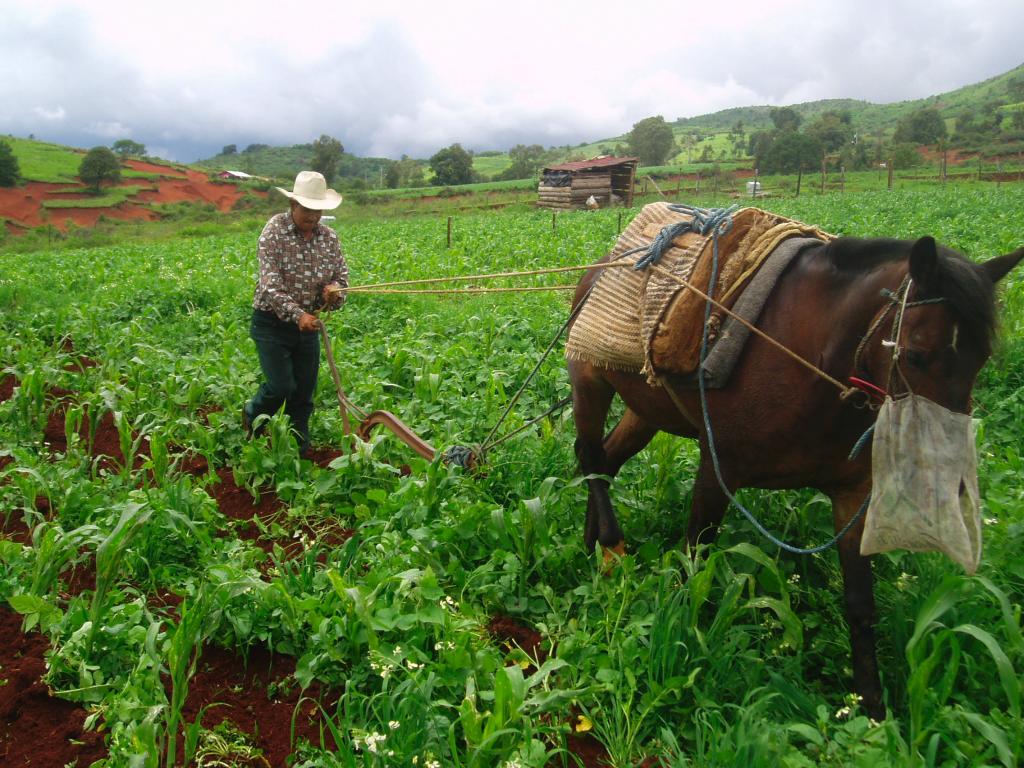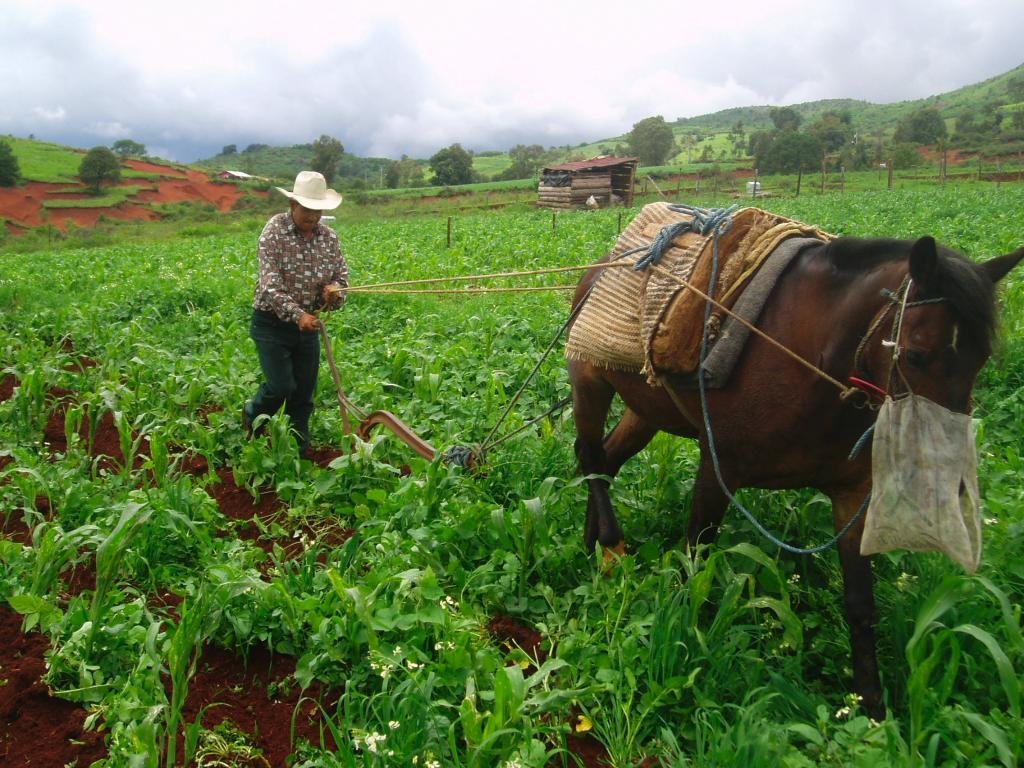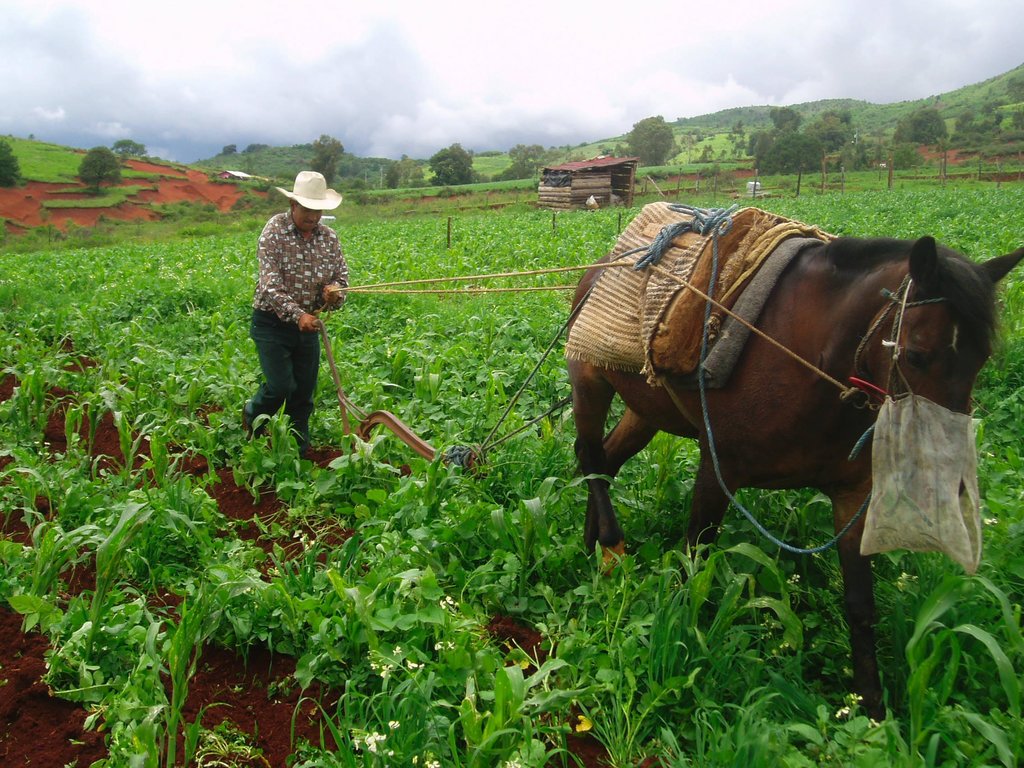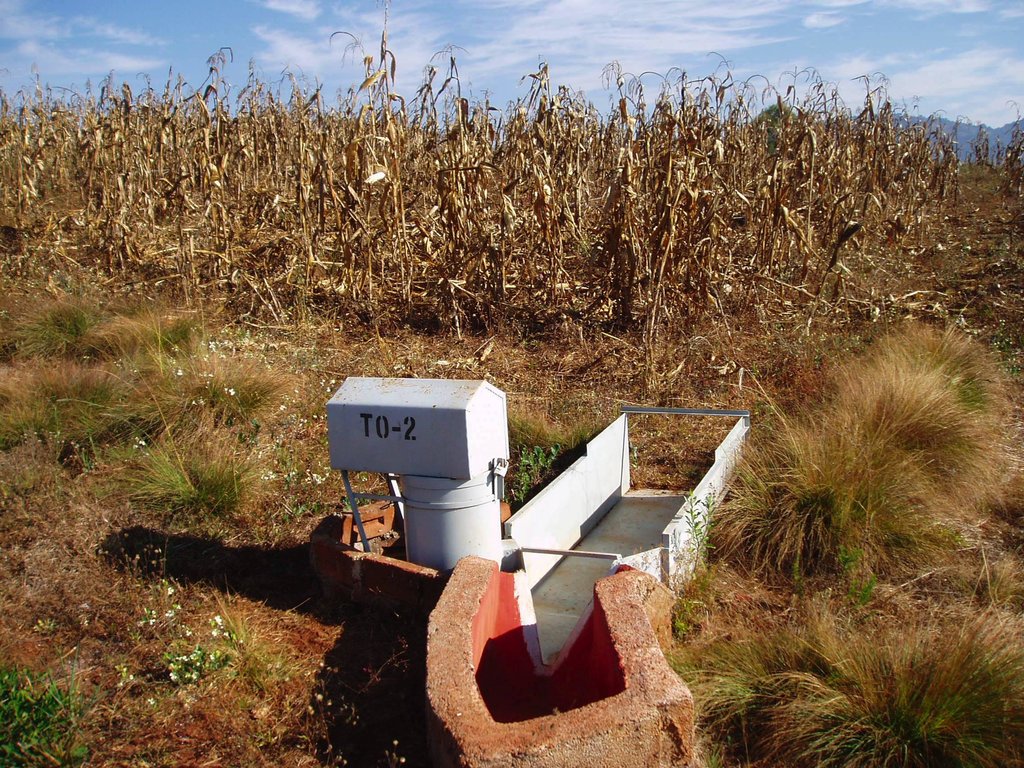Residue management of anual crop of maize/bean association [เม็กซิโก]
- ผู้สร้างสรรค์:
- การอัพเดท:
- ผู้รวบรวม: Christian Prat
- ผู้เรียบเรียง: –
- ผู้ตรวจสอบ: Fabian Ottiger
Manejo de rastrojo de cultivo anual de la asociación maiz/frijol
approaches_2579 - เม็กซิโก
ดูส่วนย่อย
ขยายทั้งหมด ย่อทั้งหมด1. ข้อมูลทั่วไป
1.2 รายละเอียดที่ติดต่อได้ของผู้รวบรวมและองค์กรที่เกี่ยวข้องในการประเมินและการจัดเตรียมทำเอกสารของแนวทาง
ชื่อของโครงการซึ่งอำนวยความสะดวกในการทำเอกสารหรือการประเมินแนวทาง (ถ้าเกี่ยวข้อง)
Institut de recherche pour le développement IRD (Institut de recherche pour le développement IRD) - ฝรั่งเศส1.3 เงื่อนไขที่เกี่ยวข้องกับการใช้ข้อมูลที่ได้บันทึกไว้ผ่านทาง WOCAT
ผู้รวบรวมและวิทยากรหลักยอมรับเงื่อนไขเกี่ยวกับการใช้ข้อมูลที่ถูกบันทึกผ่านทาง WOCAT:
ใช่
1.4 การอ้างอิงถึงแบบสอบถามเรื่องเทคโนโลยี SLM
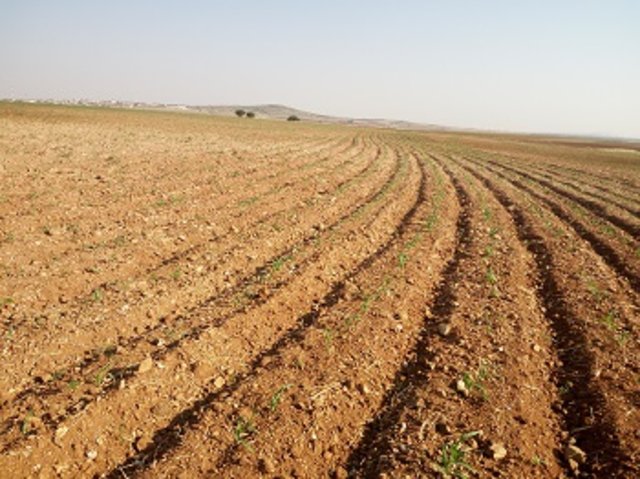
Sistemas de prácticas de MST en suelos con … [เม็กซิโก]
El sistema de prácticas de MST en planicie con pendiente no mayores del 5%, la cual consiste en la rotación de cultivos en dos ciclos denominados primavera-verano y otoño-invierno, donde en una parcela de 5 hectáreas se combinan frijol-avena y maíz-calabaza y triticale. Para el caso de la rotación frijol-avena, …
- ผู้รวบรวม: Alejandra Castillo
2. คำอธิบายของแนวทาง SLM
2.1 การอธิบายแบบสั้น ๆ ของแนวทาง
Maize residue management with high input of crop residues and annual crop instead of year one crop and fallow in year 2
2.2 การอธิบายอย่างละเอียดของแนวทาง
การอธิบายอย่างละเอียดของแนวทาง:
Aims / objectives: The objetive is to evaluate the influence of different agronomic systems including conventional system (one year tillage and one year fallow), conservation system (high input of crop residues) with mineral fertilizers every year, conservation system (high input of crop residues) with organic fertilizer every year on: water run-off (quantity and quality), soil sediment transports, soil water content, soil cover, carbon capture, soils characteristics and their interactions with the production of the maize/bean crop association on Acrisol
Methods: Primary tillage for maize/beans it consisted in moldboard ploughing and furrowing, and one post-emergence weeding was done manually. Depth of tillage for moldboard plow was about 0.20m and for rototill, about 0.15 m. 3 seeds of corn or beans are planted and covered by foot. Fertilizer is put on the depression just after seeding and one month later during the post emergence weeding. This experiment have been done on Acrisol
Stages of implementation: The experiment is finished. Dissemination to the stakeholders and policy makers has been done. Policy makers took the results and are disseminating it to the other stakeholders
Role of stakeholders: Active. Visit to the field experiment site during the experimentation, workshops, etc...but the adoption of the technologies can be effective only if the system is deeply change. Farmers need thei fallow year for their animals. This proposal is just one element of the whole system to change.
Other important information: Important results to understand and measure the soil erosion and run-off with this kind of soil (Acrisol) with the traditionnal and improaved cultural system
2.3 รูปภาพของแนวทาง
2.5 ประเทศ ภูมิภาค หรือสถานที่ตั้งที่ได้นำแนวทางไปใช้
ประเทศ:
เม็กซิโก
ภูมิภาค/รัฐ/จังหวัด: :
Mexico/Michoacán
ข้อมูลเฉพาะเพิ่มเติมของสถานที่ตั้ง:
Morelia
2.6 วันที่เริ่มต้นและสิ้นสุดของแนวทาง
ระบุปีที่เริ่ม:
2002
การสิ้นสุดลง (ถ้าแนวทางไม่ได้ใช้อีกต่อไป):
2008
2.7 ประเภทของแนวทาง
- ใช้โครงงานหรือแผนงานเป็นฐาน
2.8 เป้าหมายหรือวัตถุประสงค์หลักของแนวทาง
The Approach focused on SLM only (Soil conservation, water conservation, crop residue management, organic fertilizers, maize/bean association)
The area is strongly eroded and it was necessary to understand which factors could explain this situation and try agronomic alternatives to proposed to farmers to reduce it. In fact soil erosion is mainly due to the cattle free grazing in the field during the fodder and in commune land use for other part. The elimination of fodder year reduce presence of animals and increase production/productivity which can be given to the cattle. But this means to have less animals, more works and normally, more beneficits!
The SLM Approach addressed the following problems: Culivating every year means less space for the cattle which are the base of the agricultural system. the adoption of the technologies can be effective only if the system is deeply change. Farmers need the fallow year for their animals. This proposal is just one element of the whole system to change. New practice generates psychological resistance
2.9 เงื่อนไขที่เอื้ออำนวยหรือเป็นอุปสรรคต่อการนำเทคโนโลยีภายใต้แนวทางนี้ไปปฏิบัติใช้
บรรทัดฐานและค่านิยมทางสังคม วัฒนธรรม ศาสนา
- เป็นอุปสรรค
New practice generates psychological resistance
Treatment through the SLM Approach: Visit farmers using the new practice is very effective to convince other farmers
การมีไว้ให้หรือการเข้าถึงแหล่งการเงินและบริการ
- เป็นอุปสรรค
Actually, farmers need the fallow year for their animals.
Treatment through the SLM Approach: Follow research to complete the whole agricultural system to be able to make a global proposal which will give much more money to live, and not to survive
ความรู้เกี่ยวกับ SLM การเข้าถึงการสนับสนุนด้านเทคนิค
- เป็นอุปสรรค
Treatment through the SLM Approach:
ปริมาณงานที่ทำได้ กำลังคนที่มีให้
- เป็นอุปสรรค
Means to work the double because farmers will have all their land to work, without any fallow
Treatment through the SLM Approach: Follow research to complete the whole agricultural system to be able to make a global proposal which will give much more money to live, and not to survive
3. การมีส่วนร่วมและบทบาทของผู้มีส่วนได้ส่วนเสียที่เกี่ยวข้อง
3.1 ผู้มีส่วนได้ส่วนเสียที่เกี่ยวข้องในแนวทางนี้และบทบาท
- ผู้ใช้ที่ดินระดับท้องถิ่นหรือชุมชนระดับท้องถิ่น
Atecuaro community
Men are more involucrate in tillage activities. Men perform hard labor job in the land, while women participate in the household tasks. Nearly all the farmers of the communities are poor!
- ผู้เชี่ยวชาญ SLM หรือที่ปรึกษาการเกษตร
- รัฐบาลแห่งชาติ (ผู้วางแผน ผู้ทำการตัดสินใจ)
INIFAP (Mex. Agronomic Res.Inst.), COLPOS (Col. Postgraduate of agriculture), UNAM-CIEco, SEMARNAT (Sec. Environment)
- องค์การระหว่างประเทศ
UE project (REVOLSO then DESIRE), IRD (France), CSIC (Spain)
3.2 การเกี่ยวข้องของผู้ใช้ที่ดินระดับท้องถิ่นหรือชุมชนระดับท้องถิ่นในช่วงต่างๆของแนวทาง
| ความเกี่ยวข้องของผู้ใช้ที่ดินระดับท้องถิ่นหรือชุมชนระดับท้องถิ่น | ระบุผู้ที่มีส่วนเกี่ยวข้องและอธิบายกิจกรรม | |
|---|---|---|
| การริเริ่มหรือการจูงใจ | จ่ายเงินหรือสนับสนุนจากภายนอก | |
| การวางแผน | จ่ายเงินหรือสนับสนุนจากภายนอก | |
| การดำเนินการ | จ่ายเงินหรือสนับสนุนจากภายนอก | |
| การติดตามตรวจสอบหรือการประเมินผล | ปฏิสัมพันธ์ | |
| Research | ปฏิสัมพันธ์ |
3.4 การตัดสินใจเลือกใช้เทคโนโลยี SLM
ระบุผู้ที่ทำการตัดสินใจเลือกเทคโนโลยีมากกว่าหนึ่งวิธีไปปฏิบัติใช้:
- ผู้เชี่ยวชาญ SLM เป็นผู้ตัดสินใจหลัก ที่ติดตามให้คำปรึกษากับผู้ใช้ที่ดิน
การอธิบาย:
Decisions on the method of implementing the SLM Technology were made by mainly by SLM specialists with consultation of land users
4. การสนับสนุนด้านเทคนิค การสร้างขีดความสามารถ และการจัดการด้านความรู้
4.1 การสร้างขีดความสามารถ / การอบรม
ได้มีการจัดอบรมให้แก่ผู้ใช้ที่ดินหรือผู้มีส่วนได้ส่วนเสียคนอื่น ๆ หรือไม่:
ใช่
ให้ระบุว่าใครเป็นผู้ได้รับการอบรม:
- ผู้ใช้ที่ดิน
- เจ้าหน้าที่ภาคสนาม / ที่ปรึกษา
- Institutions
รูปแบบการอบรม:
- กำลังดำเนินการ
- เกษตรกรกับเกษตรกร
- ใช้พื้นที่ทำการสาธิต
- จัดการประชุมสู่สาธารณชน
4.2 การบริการให้คำแนะนำ
ผู้ใช้ที่ดินมีการเข้าถึงการรับบริการให้คำปรึกษาหรือไม่:
ใช่
การอธิบาย/แสดงความคิดเห็น:
Advisory service is quite adequate to ensure the continuation of land conservation activities
4.4 การติดตามตรวจสอบและประเมินผล
การติดตามตรวจสอบและประเมินผลเป็นส่วนหนึ่งของแนวทางหรือไม่:
ใช่
ความคิดเห็น:
bio-physical aspects were regular monitored by project staff through observations
bio-physical aspects were regular monitored by project staff through measurements
technical aspects were regular monitored by project staff through observations
technical aspects were regular monitored by project staff through measurements
economic / production aspects were regular monitored by project staff through observations
economic / production aspects were regular monitored by project staff through measurements
area treated aspects were ad hoc monitored by land users through observations
management of Approach aspects were ad hoc monitored by government through observations
There were no changes in the Approach as a result of monitoring and evaluation
There were no changes in the Technology as a result of monitoring and evaluation
4.5 การวิจัย
การวิจัยเป็นส่วนหนึ่งของแนวทางหรือไม่:
ใช่
ระบุหัวข้อเรื่อง:
- นิเวศวิทยา
- เทคโนโลยี
- Agronomy, hydrology, soil sciences
ให้ข้อมูลเพิ่มเติมและให้ระบุผู้ทำการวิจัย:
Measures water run-off (quantity and quality), soil sediment transports, soil water content, soil cover, soils characteristics, carbone capture, production of maize and beans by INIFAP, IRD (France), COLPOS, UNAM-CIEco and CSIC (Spain)
Research was carried out both on station and on-farm
5. การสนับสนุนด้านการเงินและวัสดุอุปกรณ์
5.1 ระบุงบประมาณประจำปีสำหรับแนวทาง SLM นี้
ถ้าหากว่างบประมาณประจำปีไม่เป็นที่ทราบแน่นอน ให้ระบุช่วงลงไป:
- < 2,000
แสดงความคิดเห็น (แหล่งของการระดมทุน ผู้บริจาคคนสำคัญ):
Approach costs were met by the following donors: local community / land user(s) (Atecuaro communities): 5.0%; government (INIFAP, COLPOS, UNAM-CIEco, SEMARNAT): 30.0%; international (UE project (REVOLSO, then DESIRE), IRD, CSIC): 65.0%
5.2 การสนับสนุนด้านการเงิน / วัสดุอุปกรณ์ให้แก่ผู้ใช้ที่ดิน
ผู้ใช้ที่ดินได้รับการสนับสนุนด้านการเงิน / วัสดุอุปกรณ์ไปปฏิบัติใช้เทคโนโลยีหรือไม่:
ไม่ใช่
5.3 เงินสนับสนุนสำหรับปัจจัยนำเข้า (รวมถึงแรงงาน)
- ไม่มี
6. การวิเคราะห์ผลกระทบและการสรุป
6.1 ผลกระทบของแนวทาง
ช่วยให้ผู้ใช้ที่ดินนำเอาเทคโนโลยี SLMไปใช้และบำรุงรักษาสภาพไว้ได้หรือไม่:
- ไม่ใช่
- ใช่ เล็กน้อย
- ใช่ ปานกลาง
- ใช่ อย่างมาก
mitigate water erosion effects and increase yields
ทำให้กลุ่มด้อยโอกาสมีอำนาจทางสังคมและเศรษฐกิจหรือไม่:
- ไม่ใช่
- ใช่ เล็กน้อย
- ใช่ ปานกลาง
- ใช่ อย่างมาก
Did other land users / projects adopt the Approach?
- ไม่ใช่
- ใช่ เล็กน้อย
- ใช่ ปานกลาง
- ใช่ อย่างมาก
Few land users due to the obligation to have new plough system, more work to manage the harvest residues
Did the Approach lead to improved livelihoods / human well-being?
- ไม่ใช่
- ใช่ เล็กน้อย
- ใช่ ปานกลาง
- ใช่ อย่างมาก
Did the Approach help to alleviate poverty?
- ไม่ใช่
- ใช่ เล็กน้อย
- ใช่ ปานกลาง
- ใช่ อย่างมาก
7. การอ้างอิงและการเชื่อมต่อ
7.1 วิธีการหรือแหล่งข้อมูล
- ไปเยี่ยมชมภาคสนาม การสำรวจพื้นที่ภาคสนาม
- การสัมภาษณ์กับผู้ใช้ที่ดิน
ลิงก์และโมดูล
ขยายทั้งหมด ย่อทั้งหมดลิงก์

Sistemas de prácticas de MST en suelos con … [เม็กซิโก]
El sistema de prácticas de MST en planicie con pendiente no mayores del 5%, la cual consiste en la rotación de cultivos en dos ciclos denominados primavera-verano y otoño-invierno, donde en una parcela de 5 hectáreas se combinan frijol-avena y maíz-calabaza y triticale. Para el caso de la rotación frijol-avena, …
- ผู้รวบรวม: Alejandra Castillo
โมดูล
ไม่มีโมดูล


